Riding the Canadian from Toronto to Vancouver, a journey of epic dimensions – and the luxury of being far removed from anything else but leisure.
Almost 4,500 kilometers in three days and four nights, and all without cell-phone coverage or Internet access. You have to tune out, de-stress and be ready to bear the lack of any intrusion. The first part is easy: departure at 10 p.m., Union Station. A whole day to take care of urgent mails and to download books and magazines. Three days and four nights, however, that’s serious.
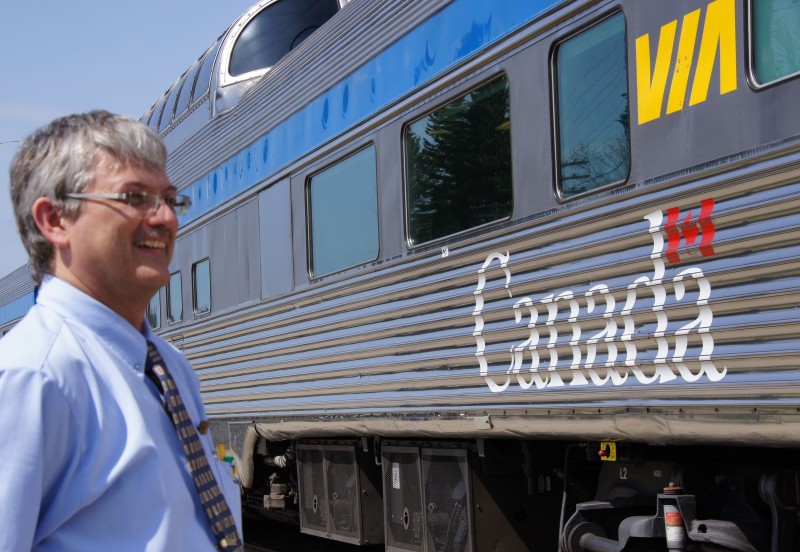
Denis tends to the train passengers between Toronto and Winnipeg, the first leg of the journey. He is steward, animator ans entertainer.
Over a glass of champagne – well, something bubbly anyway – we are introduced to the peculiarities of this train ride by Denis, our host in the so-called “action car 1”. Each day you have to book the time of your meals, which are included in the fare if you travel in sleeper-plus class. Only breakfast is always available – if you find a seat. The first lunch sitting is at 11 a.m., the second around 12:30, and the third at 2 p.m. Dinner therefore starts as early as 5 p.m. When I checked in, I had no other option but the last sitting. I don’t care.
Denis, meanwhile, is demonstrating the duck’s gait, highly recommended if you don’t want to end up with bruised elbows or sprained wrists. The aisles are very narrow, the train shakes and rattles, but if you want to reach the so-called “park car” at the end of the train, you have to brave it – that can mean as many as 19 cars. For the section to Winnipeg, our train boasts 20 cars of the sleeper-plus class and two economy cars. The bargain passengers are not allowed past the first dining car.
The two dining cars are each preceded by an action car, which consists of two halves: one is fitted out with tables, TV set, and DVD player, as well as newspapers and games; the other has a second story with a glass roof, which makes it the “dome car.” Up there it’s crowded most of the time, but at the tables you usually find empty seats unless it’s the start of school holidays. In that case the average age on the Canadian drops to below 50, because a great many families visit their relatives scattered across this gigantic country.
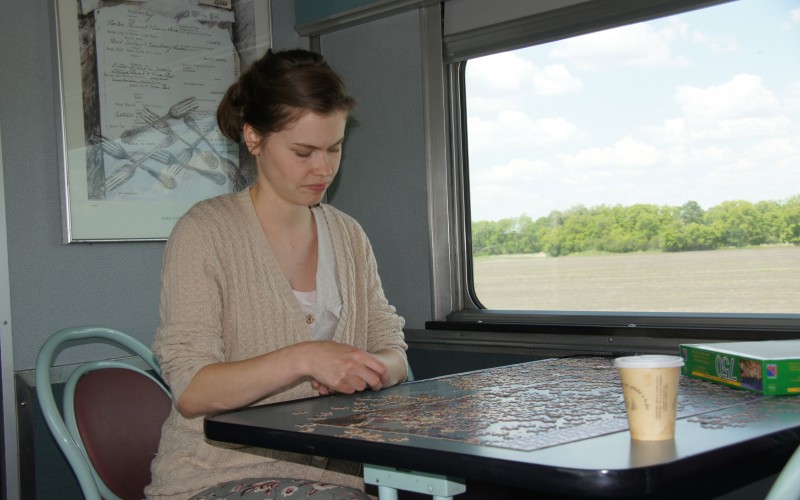
The jigsaw puzzle is ongoing, whoever feels like it starts looking for a missing piece while en route to the dining car.
If you are willing to spend more bucks on a four-day train ride than on a four-hour flight, you have time on your hands. That’s why a lot of the Canadian passengers are retirees. Not many travel individually: if it weren’t for the guided tours, the passenger segment of the Canadian National Railway would not just be unprofitable, it would go broke altogether. Two British groups are on this train. They were flown to Toronto, whisked past the indispensable Niagara Falls, and will stay one or two nights at the Rocky Mountain town of Jasper before continuing on to Vancouver and flying back to the UK.
On the lower floor of the park car, fitted out as a bar, you won’t see many of the package-deal tourists since alcoholic beverages are the only thing you have to pay for on board; all else is included in your fare. Here in the bar compartment, where some of the Agatha Christie movies would have Monsieur Poirot dissect the travel group and identify the murderer, you will mostly find individual travelers gathering for pre-dinner drinks or night caps. The park car – always named after a Canadian national park, in this case Banff National Park in the Rockies – also has an upper floor with a glass roof, but better still, a door at the back, albeit locked. Still a great spot to watch the rail tracks disappear in infinity.
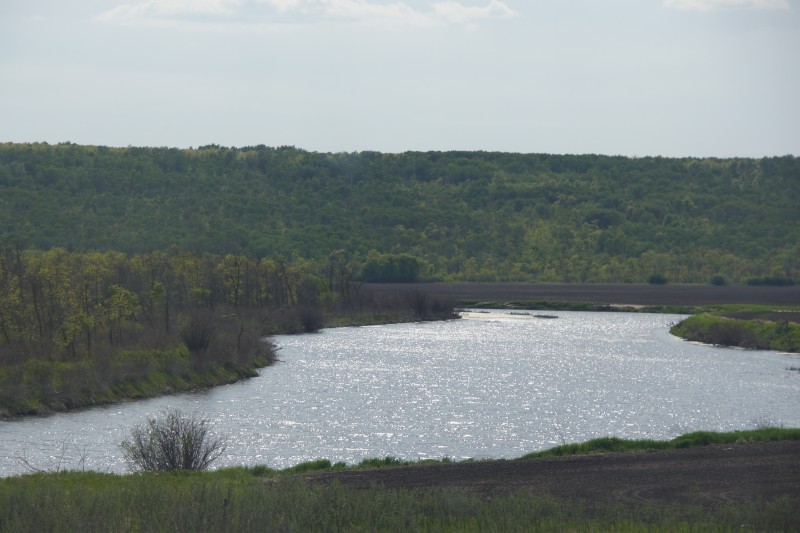
Forests and lakes as far as you can see. The scenery hardly changes between Toronto and Winnipeg.
Infinity is the most salient feature of this train ride. A pity that the doubtlessly gorgeous stretch along Lake Ontario is shrouded in the night’s darkness. Next morning, the scenery comes alive again and looks exactly like you would expect from a nation of loggers: forest after forest after forest, a few lakes and rivers in between, a lone settlement every few hours or so.
Most towns along the railway tracks survive only because of the railway. They are called railway towns and came into being when railway engineers began to open up this huge country in the 19th century. Some of the railway towns have survived as support centers for the rail service companies, others became wood-processing centers, while some turned into ghost towns because the train never stopped there or the tracks were laid somewhere else than planned.
One of the two railway companies that found their way through the Rockies and survived the development effort laid its tracks along the border with the US, through Canada’s extensive granary; the other connected the mining towns of Manitoba with the markets in Vancouver and Toronto in a sweeping arc. This is now the only route still used for passenger services, and it is owned by a company that makes the real money with cargo transportation. Which means that cargo trains will always have right-of-way.
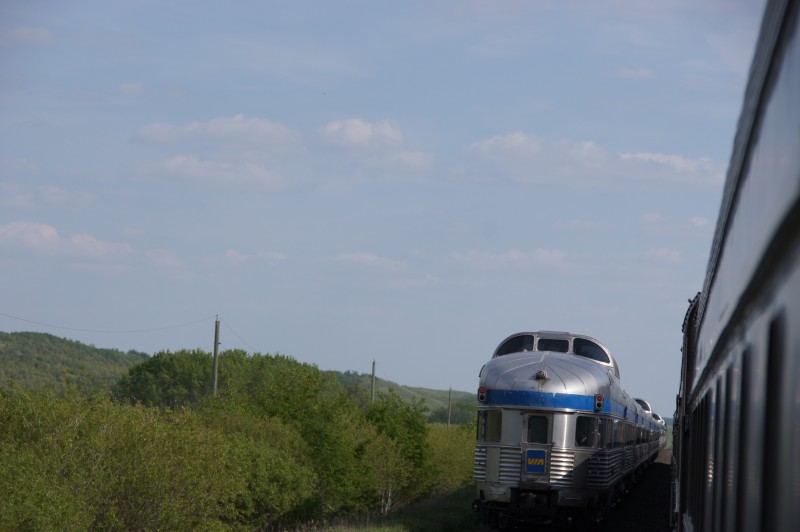
The corresponding service in the other direction crosses us. That’s only possible in a very few places, and most of the time one of the two trains has to wait for the other.
Like now, for example. We’ve been standing still for several minutes and are just being told that we will have to wait at least another 20 minutes. The railway line consists mostly of a single track, and passing loops are few and far between. No wonder will the timetable be observed once only – when departing Toronto. Some 30 minutes later the train jerks into motion, and these jerky rhythms will jolt me out of sleep several times during this first night on board.
The smokers among us hope for a quickie when the first cargo train forces us to stop, but nobody is allowed to leave the train in the middle of nowhere and in pitch-black night. Denis offers to wake up anybody who wants to take advantage of the first stop where passengers can leave the train. It is planned for 3:40 a.m. but nobody bothers. The mobile and Internet junkies aren’t exhibiting any withdrawal symptoms yet, we are only a few hours from Toronto and civilization.
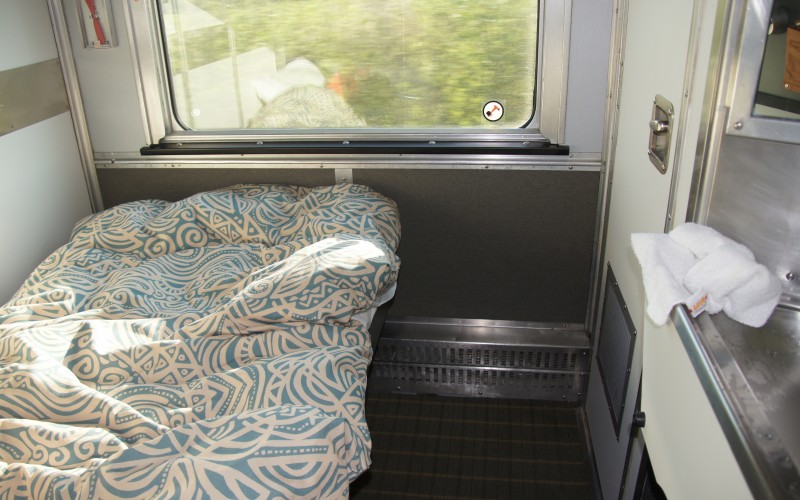
The cabins are tiny but the bed is quite comfortable. It will be folded away during the day to make room for two armchairs.
The bunk beds in the double cabin are small but comfortable, a sink and a separate toilet offer privacy, but to shower you need to go to the end of the car. The shower room is also tiny but serves its purpose, the water jet is surprisingly strong, the water hot. When I woke up we were standing somewhere in the middle of nowhere, now on my way to the dining car the train is back to its shaking and rattling. Toward 11 a.m., a good 12 hours away from Toronto, we come to the first train station: Wattford, one of the railway towns. The smokers finally get their nicotine hit, the chef is on the phone trying to find a replacement for the kitchen help, who is sick, and the passengers are happily working their smartphones and tablets. It is the last scheduled stop before Winnipeg next morning. You can board or disembark at various points between the major stations, but you have to give notice before the train leaves the closest station since any stop on a single-track line amounts to a logistics problem.
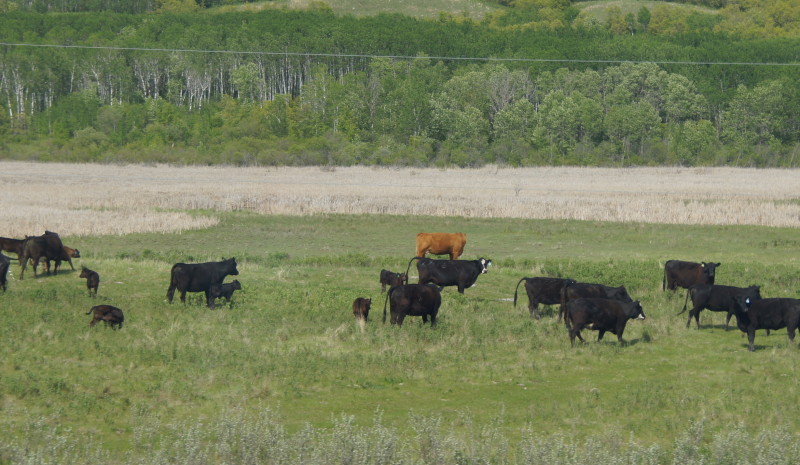
Manitoba is Canada’s prairie province. Endless pastures and every now and then a cow that stands out.
Until night falls, we are regaled with a scenery of conifers, lakes, rivers, and every so often a couple of abodes. In the beginning you are glued to the windows since this seems to be the ultimate purpose of this journey and any distraction would smack of treason. Until it dawns on you that this train ride serves exactly the purpose you are giving it. Like reading for hours on end without disturbance. Or listening to Denis talking about Canada’s history, or finding a few pieces for the jigsaw puzzle that is there on a table for use by anybody, or taking part in a wine tasting session which, for lack of a decent wine menu, could only interest beer-guzzling first timers.
Between the forests of Ontario and the Rockies lies the prairie: hundreds of kilometers of pasture land, every so often a mining town, and yet more pastures, all canopied by an infinite sky. Only when we approach Jasper on the third day, with a three-hour delay, does the scenery become more varied and more interesting. The climb up to the Rocky Mountains takes us past spectacular waterfalls and across sky-high viaducts; the cameras are in constant use. Jasper is hardly ever reached on time, so nightfall comes much sooner than your vista-searching soul would want, and once you leave Jasper, the journey is pretty much over. A last night on the train, a last night cap in the park car, which a casually developing circle of nice people turns into a rather extended session, and a stroll back to the cabin made all the more lurching by the extra night caps.

Finally, when leaving Jasper, the Rockies provide some stunning scenery. But soon it will be dark and by morning we will have reached the plains and be riding along the river toward Vancouver.
The chance encounters are what makes this train ride special. I meet train aficionados who ride any famous railway line, four well-seasoned Indians who once a year meet up, the wives included, to commemorate their college graduation in Mumbai. I meet a pre-school teacher from Edmonton who left British Columbia to be closer to her daughters only to see them move back to BC. She says she normally takes the plane to Vancouver but wanted to do the train journey just this once. I meet the couple from Toronto who happened to see the half-price deal of Canadian National and seized the moment, or the American woman who spent three months with a friend and is now in no hurry to get back home.
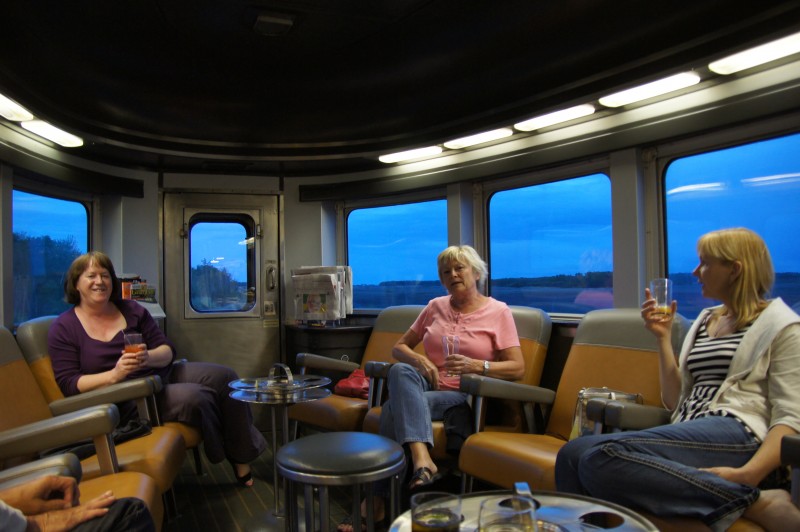
Women in motion. When you take time for a train ride through the immensity of Canada you also have time for a friendly chat in the park car.
I also meet members of the British tour group who are bored stiff, travelers who cannot condone a three-hour delay to Jasper, or those who keep harking about the 20-dollar price tag for a half bottle of wine.
Amazingly, I don’t meet anybody who suffers from mobile or Internet withdrawal. It’s quite nice actually to belong to a generation that can indulge in something without feeling compelled to “like” everything.
Translated from German by Rosemarie Graffagnini
